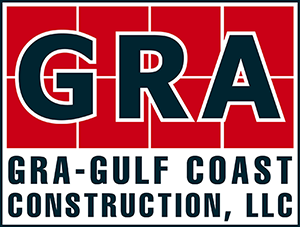 Houston industrial construction is responsible for some of the most successful and profitable petrochemical plants and factories in the world. While the towering heights and sprawling landscapes might seem like the most impressive part of these construction projects, the true strength is found in the material found beneath the surface – rebar. This is a type of steel bar that may seem simple at first glance, but when used with concrete, it can offer unmatched strength and durability for vital industrial buildings. At GRA Gulf Coast Construction, we understand that when it comes to industrial construction in Houston, the foundation is sometimes the most important step. That step requires rebar for optimal strength and resilience.
Houston industrial construction is responsible for some of the most successful and profitable petrochemical plants and factories in the world. While the towering heights and sprawling landscapes might seem like the most impressive part of these construction projects, the true strength is found in the material found beneath the surface – rebar. This is a type of steel bar that may seem simple at first glance, but when used with concrete, it can offer unmatched strength and durability for vital industrial buildings. At GRA Gulf Coast Construction, we understand that when it comes to industrial construction in Houston, the foundation is sometimes the most important step. That step requires rebar for optimal strength and resilience.
Rebar Through the Ages: How it Evolved Into an Industrial Super Material
Although construction has nearly always required some sort of foundation, methods have significantly changed over the years to create what most construction teams use today. Houston’s industrial construction projects require the most modern and highly specialized foundational techniques possible to reinforce the crucial products being manufactured.
The first traces of using reinforcement for construction foundations go back to the Roman Empire, when pozzolana was discovered near what is now Naples, Italy. Pozzolana is a siliceous and aluminous material that derives from volcanic ash. Because the silica component is highly reactive, it creates a material similar to cement when combined with lime. This was used for many of the most iconic buildings of the ancient age, including the Colosseum and the Pantheon in modern-day Rome.
During the Middle Ages, many medieval builders began to use iron rods and chains to help further support unique structural elements like archways or vaults. While these were all engineering marvels during that time period, rebar has come a long way since the invention and modernization of structural reinforcement for industrial construction.
Engineering a Stronger Future: The Birth of Modern Reinforced Concrete
Throughout the history of early civilizations, structural reinforcement was a system based on trial and error, but in the middle of the 19th century, a noticeable shift occurred. This shift was pivotal to the future of construction for industrial powerhouse cities like Houston. The primary inventors of the beginning of modern structural reinforcement techniques included two key scientists:
- François Hennebique was a French engineer who created the first patented method of using reinforced concrete for construction. He started using reinforced concrete slabs in 1879 with both stirrups and longitudinal bars to increase the tensile strength of the foundation. He used all sorts of steel for these structures, including rods, bars, and even mesh. Along with creating the steel reinforcement technique, Hennebique also revolutionized construction by proving that concrete is one of the most crucial materials for construction.
- Joseph-Louis Monier was a French commercial gardener who invented the method of using chicken wire to reinforce his cement and concrete tubs or basins. The embedded chicken wire made these garden installations remarkably strong, which led him to patent his creation in 1867. It was this technique that inspired Hennebique after he saw Monier’s design at the Paris Exposition the same year.
One of the most vital elements in the development of modern concrete reinforcement techniques was the new widespread availability of mass-produced steel that occurred during the Industrial Revolution. Invented by Henry Bessemer in 1856, the Bessemer Converter Process made steel production extremely cheap, fast, and easy for manufacturers. Many engineers realized that this newfound material, now called rebar, had the perfect strength and flexibility to vastly improve industrial construction techniques.
The Ideal Partnership: Why Steel Rebar and Concrete Are The Ideal Combination for Industrial Construction
As the widespread availability of rebar drastically increased across the globe, its tensile strength and flexibility made it essential for many impressive industrial structures. While there is an extensive variety of reasons for rebar and concrete making an ideal combination for durable, reliable foundations, the most important factors include:
- Unmatched tensile strength: While concrete is one of the strongest elements used in industrial construction, its strength is significantly higher under compression than it is under tension. By incorporating rebar into foundations and other vital support elements, the building gains strength throughout both compression and tension.
- Thermal compatibility: Thermal expansion plays a massive role in the safety of construction, especially in industrial complexes in Houston, where materials manufacturing can require extremely hot or cold conditions. Because both concrete and rebar expand and contract in similar ways, they are ideal for preventing internal stresses and cracks that could lead to detrimental damage.
- Superior bonding: The last stage of rebar’s development was making it ribbed instead of smooth. Adding ridges to the bar’s surface creates more grooves for concrete to adhere to the bar, leading to increased tensile strength due to a stronger bond between the materials.
Based on these factors, industrial construction, especially in Houston’s demanding scene, uses rebar as one of the most efficient materials. By working with professionals like GRA Gulf Coast Construction, you can be confident that your rebar and concrete foundations can truly stand the test of time.
The Future of Rebar in The Houston Industrial Construction Scene
While using reinforcement for concrete construction has been around for ages, when it comes to the Houston industrial construction scene, rebar is here to stay. As construction teams continue to develop new methods, rebar will also continue to evolve into an even more efficient reinforcement material. GRA Gulf Coast Construction strives to continuously pursue excellence for our Houston industrial construction projects by staying in the know on the industry’s most advanced technology.
One of the most important new developments is transforming rebar from a passive reinforcement tool to an intelligent and active monitoring system within your building. “Smart rebar” is revolutionizing how we monitor and inspect buildings by using embedded sensors to track things like concrete strength and moisture throughout the curing process.
This is just one newfound technique that could lead to a safer, smart future for industrial construction in Houston. When you work with a team of construction experts like GRA Gulf Coast Construction, you can be sure that we will equip your project with the newest, most dependable materials on the market.
Houston’s Steel Bones: The Material That Shaped The City of Industry
Rebar is a perfect example of a simple idea that grew into one of the most vital components within modern-day industrial construction. In Houston, it has contributed to the development of the city’s thriving oil and gas market, impressive chemical plants, and eye-catching skyline. These buildings are not only essential to Houston, but they also power a large amount of the world’s oil and gas industry, making rebar one of the most important materials worldwide.
The team at GRA Gulf Coast Construction understands how valuable rebar is for Houston’s industrial construction scene and for our client’s specific needs. If you’re looking for a team of construction experts who have years of experience building dependable, reinforced structures with rebar, look no further. We have been working on some of Houston’s largest industrial construction projects since 1998, and consistently strive to provide our clients with fast, efficient, and safe service. Contact us today to receive a construction estimate for your next industrial project in Houston!
